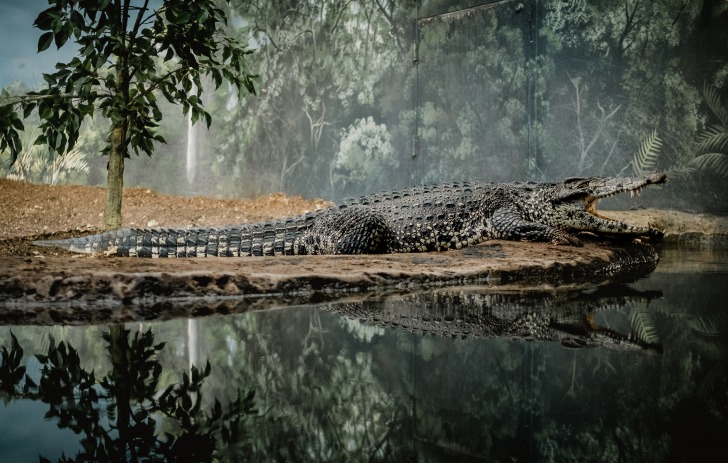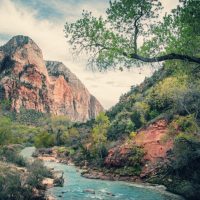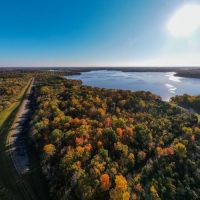Oklahoma does sometimes reach 100 degrees.
However, it still doesn’t have the capacity to handle alligators across the entire state.
Contents
So… Are There Alligators in Oklahoma?
David Arbour took a photo of an alligator nest found at the Red Slough Wildlife Management Area (WMA) in 2005.
You’ll mostly find them in Southeastern Oklahoma, and some tend to reside in the Gulf Coastal Plain.
A 2022 report confirms that alligators still reside within OK.
However, it’s only in a small section of the state.
“Any further west or north in the state, it’s just too cold for them,” said Micah Holmes, Oklahoma Department of Wildlife Conservation.
Holmes did, however, add that the alligators that do exist in OK are native.
They just have to stay right where they are to survive – usually.
There was an instance of alligators going into hibernation mode to survive a Red Slough frost that had occurred in February 2021.
So, even though they usually don’t, it’s possible for them to make it in freezing temperatures in a life-or-death situation.
I’m not sure if it’s just a rumor, but baby alligators may have been found in other locations, such as Oklahoma City and Tulsa.
However, it hasn’t been determined if some of these were pets released accidentally into the wild or what.
One of them was only 29 inches long.
If they have been in the state since the 1800s though, it’s probably true.
Some updates came from findings in the 1970s.

Alligator Species in Oklahoma
The American Alligator is the only alligator species from the United States, showing up in Oklahoma sometime in the 1800s.
As of May 2022, one of the latest sightings of it took place at Claremore Lake.
The Oklahoma Department of Wildlife Conservation (ODWC) released this information.
This particular one measured 9 feet 6 inches.
Unfortunately, that particular animal had to be euthanized.
I do respect the reasons, such as its original whereabouts being unknown and not knowing what diseases it had.
I could help but feel a little sad though.
Apparently, there wouldn’t be many places in the state conservationists could have transported it to anyway.
At least the ones at Red Slough seem to thrive, and one even survived during an OK cold spell.
Is it Safe to Swim in Oklahoma?
If alligators are your biggest concern, I would suggest you not swim near the Red Slough WMA.
As far as I know, you can’t swim there anyway.
Other activities take place here though. You can view the wildlife map of the area before you explore Red Slough, and you need a license to hunt or fish here.
Fishing takes place before October 15th and after January 31.
Places You Can Swim in OK
Before I divulge the topic of water contamination, I will first let you know where you can swim.
Some OK places to swim recommended by Metro Family Magazine include the Pennington Creek Dam in Tishomingo and Beavers Bend in Broken Bow, which is SE Oklahoma.
Other recommended swimming spots include Turner Falls Park in Davis and Blue River, another Tishomingo water spot.
These aren’t the only places you can swim, but now you have an idea of where you can go – and where the alligators aren’t.
Water Cautions to Take
The health department has put out routine alerts warning of contamination that pertain to swimming in natural waters.
You can, for example, refrain from swallowing water, wear goggles or water masks, and use earplugs.
This includes when enjoying lakes, streams, and rivers, which aren’t disinfected like swimming pools.
Wearing the appropriate protective equipment will prevent infections, such as e. Coli.
Beware of swimming in the presence of blue-green algae too.
It causes rashes in some people, and don’t swim in water where you know factories dump pollution.
Interesting Alligator Facts in Oklahoma
The American Alligators, which you don’t find often in OK, typically like to live in freshwater areas, such as in swamps, marshlands, streams, lakes, or rivers.
That’s the reason you may see them in some of the remote southeastern areas of the state.
You may find them in Choctaw, Love, McCurtain, and Bryan counties.
Other Alligator Facts:
- Alligators can’t breathe underwater. They have lungs because they’re reptiles, not fish or amphibians that can breathe underwater. That’s why you’ll usually see their nostrils above the waterline as they watch for prey.
- Their skin color changes (sort of). Alligators’ skin changes color depending upon the water they’re in. That makes them somewhat of a chameleon. Water with algae in it makes them look greener even though they’re originally black or dark gray.
- They don’t need to eat that often. I found this quite amazing. Some alligators can live at least two years without eating. Let’s just hope they’re not hungry when they find you, but humans aren’t their favorite food anyway.
- They hold their breath for an hour or more. Just because they don’t breathe underwater, that doesn’t mean they need to breathe often. I remember when I was about 10 learning how to swim. I could barely hold my breath for a minute, let alone an hour like an alligator. I’ve heard that some even hold their breath for anywhere from 8 to 24 hours on rare occasions.
- Alligators can hibernate to save themselves. Even though OK alligators don’t typically like the cold, they can survive. During the 2021 Red Slough frost incident, these cold-blooded creatures conformed to their environment as their heart rate, metabolism and breathing slowed.

Alligators vs. Crocodiles
Both alligators and crocodiles belong to the Crocodylia order, which classifies 23 large reptiles and amphibians.
They also both have a scaly skin appearance and long snouts.
However, they have distinct differences.
1. Their Snouts
Alligators have a rounded snout, shaped like the letter “U.”
A crocodile typically has a snout with a pointed shape like the letter “V.”
Alligator head sizes often measure wider than a crocodile’s head, but the crocodile’s head is often longer.
2. Weight
Crocodiles usually weigh more than alligators, averaging about 1,000 pounds for males.
They can weigh up to 2,200 pounds.
Unlike crocodiles, male alligators may only reach an average weight of 500-600 pounds.
The females don’t weigh as much as the males.
They can weigh up to about 1,000 pounds though.
3. Size
The alligator grows to at least 10-15 feet.
However, some crocodiles grow to at least 17 feet long.
The Nile Crocodile, however, grows up to about 20 feet.
4. Mouth and Teeth
You won’t see much of an alligator’s teeth when its mouth is closed like you would a crocodile.
That’s because the alligator has somewhat of an underbite (lower jaw shorter than the upper one).
You might see some “fangs” extending out from an alligator’s upper jaw though.
I never knew the difference between a crocodile and an alligator until now.
All I know is, I would picture the toothy smile that sometimes makes me chuckle when I see it in pictures.
It’s the croc’s resting position, but it makes me think they’re smiling and/or laughing like in cartoons.
5. Texture and Color
The round dots that you see on both alligators and crocodiles are sensors that alert them of nearby prey.
Alligators only have these sensors around their mouths, but crocodiles have them all over their bodies.
I wondered if the appearance of the sensor “dots” all over a crocodile’s body is part of what makes their skin look rougher.
By the way, these sensors help them detect movement via water pressure, which determines the presence of another animal.
I think the round dots all over their body do make crocodiles look like they have a rougher texture than an alligator.
However, I did find out that alligators do have smoother skin and smaller scales than crocodiles.
As far as color, crocodiles are usually lighter colors, such as olive or tan.
The alligators typically appear black or gray, but they often have a light underside.
6. Saltwater vs. Freshwater
Crocodiles may live in swamps or rivers that flow at a slow pace.
However, they tend to handle saltier water than an alligator would.
An alligator’s salt glands don’t work fast enough for them to navigate in the Caribbean like would a crocodile.
3 Safety Tips for Swimming in Alligator-infested Waters
1. Observe alligators from a distance.
Micah Holmes says that they (The Department of Wildlife Conservation) do not recommend interacting directly with the alligators.
Instead, observe them from a distance.
2. Pay attention to swimming reports.
You can find plenty of places in Oklahoma to swim where you don’t have to contend with alligators.
There’s no need to swim in places where you’re told not to.
I personally don’t think I would swim in the Red Slough WMA area.
It’s in the news all the time, referencing the alligators that are there.
3. Don’t ever swim by yourself.
Swimming in groups of three or four people would provide the most protection against danger.
One person could stay near the shore remaining on the lookout while two or three people venture to deeper waters.
Personally, I don’t swim in water over my head in unfamiliar territory.
Summary
Oklahoma does have alligators.
You’ll hardly ever see them though unless you spend most of your time near the Red Slough Wildlife Management Area.
They may show up in Choctaw, Love, McCurtain, and Bryan counties.
Oklahoma Safety Overview
READ THE FULL REPORT: Oklahoma Safety Review
Safety Index:
- OVERALL RISK: MEDIUM
- TRANSPORT & TAXIS RISK: MEDIUM
- PICKPOCKETS RISK: MEDIUM
- NATURAL DISASTERS RISK: MEDIUM
- MUGGING RISK: MEDIUM
- TERRORISM RISK: LOW
- SCAMS RISK: MEDIUM
- WOMEN TRAVELERS RISK: MEDIUM
Frequently Asked Questions
What do alligators usually eat?
They typically eat any meat they can find.
This includes birds, fish, frogs, and snails or invertebrates.
They might also eat mammals, such as whitetail deer, small black bears, and raccoons or otters.
They usually prefer animals other than humans if they can find them.
Do alligators eat humans?
I felt relieved when I found out that humans aren’t an alligator’s first menu choice.
However, that doesn’t mean they never would.
In most cases, they won’t eat a whole human, but having them take a bite out of an arm or leg doesn’t sound like much fun.
Are alligators and crocodiles the same thing?
Alligators and crocodiles are the same in that they’re both a type of reptiles.
However, they come from different families.
Alligators are Alligatordae, and Crocodiles are Crocodylidae family members.
Can an alligator really hold its breath for 24 hours?
It depends on the species.
The American Alligator typically holds its breath for 10-15 minutes, sometimes 20-30, or even a couple of hours when resting.
It’s possible for them to hold their breath for at least eight hours in extremely cold water.
On rare occasions, they have held their breath for about a day.












Alligators can survive in Oklahoma, but they are mostly found in Southeastern parts of the state and some reside in the Gulf Coastal Plain; swimming near Red Slough WMA is not recommended due to alligator presence.